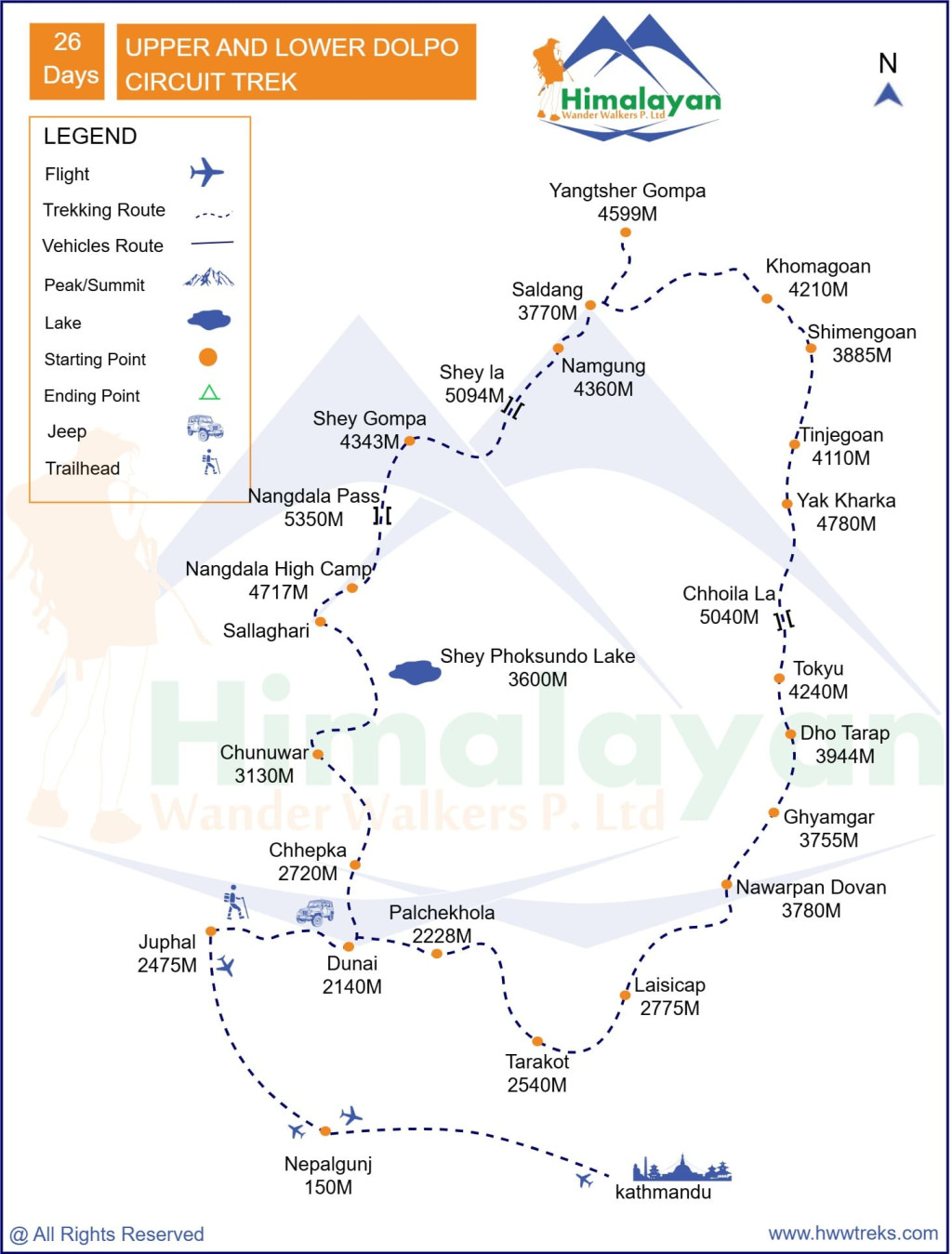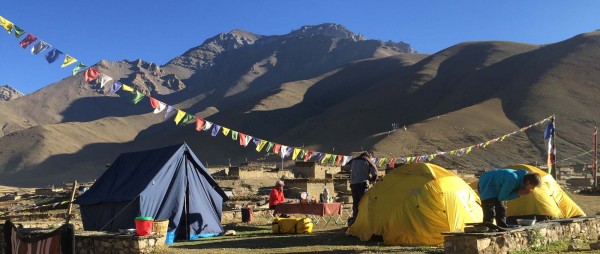Important Information
Region
Dolpo Region Treks
Duration
26 Days
Max Altitude 5350m
Best Season April to mid-November
Activity Per Day
5-6 hours
Grade
Level Level 3
Group Size
2 - 12 people
Transportation Flight
The Upper and Lower Dolpo combined trek is called the Dolpo Circuit Trek. This camping trek takes you into one of Nepal's most remote and least-visited trekking destinations, the Dolpo Region in the western Himalayas.
Trekking in Dolpo is recommended by many books such as “Snow Leopard by Peter Matthiessen” and documentaries. Dolpo is a high valley northwest of Nepal, one of the most untouched trekking destinations. Dolpo is literally “The Hidden Valley”, and is isolated from the rest of the world by some of the highest peaks on the planet, and by passes over 5,000 m above sea level. Dolpo is different from other trekking regions of Nepal which is inspired by mystery and spirituality.
Upper and Lower Dolpo Circuit Trek Route:
The Upper and Lower Dolpo Circuit trekking route is designed clockwise because it is easier and also a religious belief to circumambulate in the right direction. The treks start from Juphal after taking a short flight from Nepalgunj. There is an old trekking trail from Juphal to Sulighat but there is a drivable road also available. From Sulighat you will cross the Bheri River suspension bridge and follow the trail to Phoksundo Lake. It will take 4 days to reach Phoksundo from Juphal. To have better acclimatization you will have one day to rest at Ringmo to explore around the Lake. From Phokdundo you will trek to Sacred Shey Gompa. Between Shey Gompa and Phoksundo, there is no village at all. So, few overnight places remain remote and peaceful. In Shey, you will have one more day exploring the Shey Gompa and Tsakang Gompa that lie in the foothills of Crystal Mountain. After completing the Shey Gompa pilgrimage you will continue your trek to Saldang by passing Namgung. In Shey you will have a side trek to Yangzer Gompa and trek to Dho Tarap via Koma, Shimen, Tingyur/Tinje, and Yak kharka. From Yak Kharka you will cross the Chhoila la (5040m) Pass. From Dho Tarap the elevation decreases and you will trek down toward Dunai via Nawalpani and Lasicap of Tichurong valley. From Dunai, drive to Juphal and fly back to Kathmandu with a connecting flight at Nepalgunj.
Highlights of Dolpo Circuit Trek
- The Dolpo region in Nepal features a rugged landscape of snow-capped peaks, high passes, deep gorges, and arid valleys, offering a mix of dry and desert-like terrain, lush valleys, and dense forests.
- Dolpo being heavily influenced by Tibetan culture is seen through ancient monasteries, remote villages, and Buddhist stupas, including the sacred Shey Gompa and Ringmo Village near Phoksundo Lake.
- Shey Phoksundo Lake, a turquoise alpine lake surrounded by peaks, is a stunning, sacred site of the trek offering dramatic and peaceful scenery.
- The trek crosses high-altitude passes like Shey La Pass (5100m) and Nangda La Pass (5240m), providing panoramic views of snow-capped mountains such as Kanjiroba Himal, Dhaulagiri, and Himalchuli.
- The trail passes through diverse ecosystems, from subtropical forests to alpine meadows, home to wildlife like snow leopards, blue sheep, Himalayan tahr, and various birds.
Reference for Planning your Trek in Dolpo: Trekking in Dolpo Guide
If you are looking for a different itinerary than the one here, please Customize Your Trip.
Include
Trekking Guide: Speaking English, Nepali, Tibetan language
Camping Trek Crew Members (Cook, Kitchen Staff, Mule driver, etc)
Two way flight fare (Ktm-Kep-Dolpo-Kep-Ktm)
Porters or Mules to carry load
Trekking equipment: Chairs & tables , mattresses, member tents, kitchen/dining tent, toilet tent, bedding bags, first aid kit
Food: Three times meal (Breakfast, lunch and dinner), with different items
Drink: Tea, Coffee, Juice etc. with light snacks, biscuits, cookies etc. along with fruits and chocolates
Accommodations for two nights at 3 Star hotel in Kathmandu
One night 3 Star hotel in Nepalgunj
All Trekking Permits
Exclude
Nepalese visa fee
Excess baggage charge for domestic flight
Extra night accommodation in Kathmandu because of early arrival, late departure, early return from mountain (due to any reason) than the scheduled itinerary
Meals in Kathmandu
International Flight fare
Travel and rescue insurance
Personal expenses (phone calls, laundary, bar bills, battery recharge, extra porters, bottle or boiled water, shower ect.)
Gratitude for Crew members
Route Map

Important Information
CHECKLISTS FOR UPPER AND LOWER DOLPO CIRCUIT TREK
- Valid passport (valid for six months from the date of your trip)
- MasterCard, Visa Credit, and Debit Cards are accepted in Nepal. However, some cash is highly recommended.
- Mobile (if your cell phone is from CINGULAR USA or ATNT (USA) operators, then your cell phone will work in Nepal.)
- Clothing (Layered clothes, windproof and waterproof jackets, fleece pullovers, thermal base layers, hiking pants, shorts, headwear, footwear, and other items according to your needs)
- Personal Items and Toiletries (First-Aid Kit, Iodine tablets or a UV purifier to treat water, Sun Protection)
- Travel and Health Insurance
- Trekking gear and equipment(if you have your own trekking gear and equipment, such as trekking poles, sleeping bag, and shoes, then you can bring them; else you can rent them in Thamel, Kathmandu). Read more for trekking gears and peak climbing gears.
Best Time to do the Dolpo Circuit Trek
The Dolpo trekking seasons last from April to mid-November. May and October are considered the best time among the above-mentioned months. During these months the skies remain clear and the temperature remains moderate. Pre-planning for the Dolpo trek is highly recommended as it requires a full camping trek. Trekking in summer is also recommended by many because of the rain shadow area, Dolpo receives less rain. During that time the weather is not really cold nor too hot, suitable for trekking. However, the challenge is that the flight from Nepalgunj to Juphal may get canceled due to weather issues in the lowlands of Nepal. If you are planning your trek during the summer time then we suggest you keep 1- 2 days extra, in case the flight doesn't take off as per the itinerary date. Roadway is always the first option if the flight doesn't take off.
Who should trek in Dolpo?
The Dolpo circuit trek is a challenging trek that requires a good level of physical fitness and experience in high-altitude trekking. Some trek days are long and there are multiple high passes above 5000 meters. Proper rest day (acclimatization is crucial to avoid altitude sickness). If you have done some high-altitude treks such as Kanchenjunga, Everest Three Passes, Manaslu Circuit, Thorang Pass, and Upper Mustang Circuit then you can join this trek.
Guiding, Food, and Camping
In Nepal, all trekking supplies - camping equipment, kitchen implements, food - are carried by pack animals like mules, Yaks, and horses. Even Porters are common in Nepal. All trekkers are accompanied by a guide, a cook, and usually at least one horseman or yak herder. With the surest footing; they lead trekking groups across the passes. The horseman and cook will usually run ahead during a trekking day. They will have prepared a packed lunch for hikers and will go on to the night’s resting place to set up camp. They set up tents, cook dinner, and ready the area for arriving trekkers. When trekkers reach the campsite they are greeted with a hot cup of tea and biscuits in the dining tent. After six hours in the mountains, no drink will ever taste sweeter. For dinner, the cook will usually prepare a buffet of dishes that are as welcome as they are delicious.
DRESS CODE FOR VISITING MONASTERIES, AND TEMPLES
- Shirt (either half or full sleeve)
- Full pants/long skirts
- Any type of shoes with socks
- No Hats, No Umbrella, No Slippers, No t-shirts, No short skirt, and No half-pants
- Photographs are allowed in the courtyard only.
Note regarding itineraries
Although we generally adhere to the schedule, the itinerary is subject to change for numerous reasons beyond our control, including weather and terrain conditions, suitable campsite availability, and the group's general fitness level. It is important to understand that our trek is logistically complex and it is not unusual that adjustments be made. Our guide will orient you each evening to the following day's plan; their good judgment is the key to the long history of successful treks that Himalayan Wander Walkers has led till now. Please remember that our ability to make adjustments as needed helps to ensure that your trek is successful.
Frequently Asked Question
Yes, you can customize the Dolpo Circuit Trek. Depending on your preferences, we can adjust the itinerary to suit your needs, such as shortening or lengthening the trek or adding extra days for rest. If you have specific interests, like visiting certain monasteries or villages, we can tailor the route to accommodate those. Just let us know your preferences, here “Customize your trip”.
No, you can't do the Dolpo Circuit Trek as a teahouse trek. The region is remote and lacks the infrastructure of teahouses or lodges, especially in the more isolated areas of the trek such as Phuksundo Lake, Chhepka, Nangdala HC, Saldang, and many more. This trek is best suited for camping, as it allows you to explore some of the most untouched parts of Dolpo.
If the flight from Nepalgunj to Juphal gets canceled due to weather conditions, we always have a backup plan. The first option will be to drive to Juphal, as there is a drivable road available from Nepalgunj. It’s always wise to have 1-2 extra days in your itinerary to accommodate any delays caused by weather issues.
Yes, the Dolpo region is home to some incredible wildlife. On this trek, you might have the chance to see snow leopards, blue sheep, Himalayan tahr, and various species of birds. The area is part of the Shey Phoksundo National Park, which is rich in biodiversity, and you may even encounter these animals in the more remote parts of the trek, especially during the quieter hours.
For the Dolpo Circuit Trek, you’ll need high-quality trekking gear suitable for cold, high-altitude conditions. This includes waterproof trekking boots, warm layers (including a down jacket), gloves, hats, a sleeping bag for cold temperatures, trekking poles, and a good-quality backpack. A comprehensive packing list will be provided before departure, ensuring you have everything you need for comfort and safety. For more details read our "Trekking Gear & Equipment Blog".
During the Dolpo Circuit Trek, access to phone networks and the internet is very limited. The remote nature of the region means that signal is only available in certain villages, and internet connectivity is practically nonexistent for most of the trek. It's a great opportunity to disconnect and immerse yourself in nature, though. You can always carry a satellite phone for emergencies, which we can arrange for you.
Altitude sickness is a common concern when trekking in high-altitude regions, and we take it seriously. To mitigate the risk, we have built-in acclimatization (rest) days into the itinerary, allowing your body to adjust gradually to the changing elevation. Staying hydrated, eating well, and taking things slow are key to avoiding altitude sickness. If symptoms like headaches, nausea, or dizziness appear, we encourage resting and informing your guide, who will follow proper protocols. It’s important to listen to your body and communicate any concerns during the trek.
No questions found matching your search. Try different keywords or browse all questions above.
| {{type.min}} - {{type.max}} Pax {{type.name}} - {{type.desc}} | {{type.display_price}} per people |
Extra prices:
Let us help you decide Inquiry
You might also like

- 25 days
- Dolpo Region Treks
Upper Dolpo To Mustang
Trekking in Upper Dolpo and exit through Jomsom in Mustang is the only ultimate trekking region in Nepal which will bring you a truly rewarding experience. Dolpo is one of the biggest districts of Nepal with the neighboring districts of Mustang on the south, Mugu and Jumla on the west, and Rukum on...



